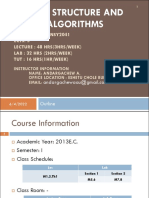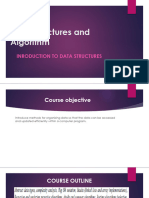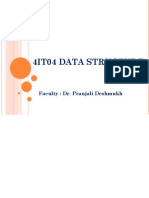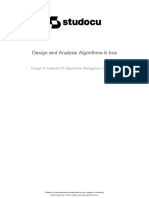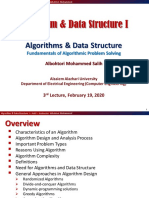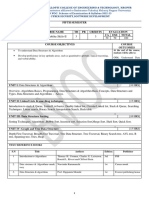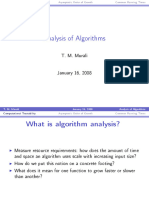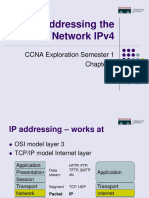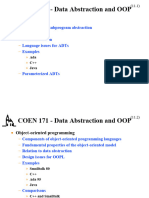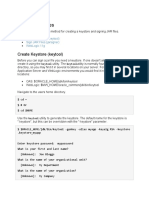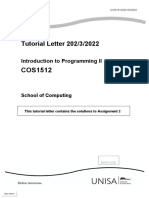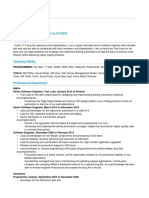Select Business and Technology Collage
CSC 413:Theory of Algorisms
Data Structures and Algorithms Analysis
By: Samuel M.
Chapters Content
Introduction
Dynamic programing
Graph Theory
Queue
Data Structures and Algorithms Analysis 2 2 June, 2021
Chapter 1: Introduction
Algorithms Analysis
Properties of an algorithm
Algorithm Analysis Concepts
Complexity Analysis
Data Structures
Classification data structure
Abstract Data Types
Simple and advanced searching and sorting algorism
Data Structures and Algorithms Analysis 3 June, 2021
Chapter 2: Dynamic Programing
Dynamic programing: top-down approach
Greedy algorithms: bottom-up approach
Chapter 3: Graph Theory
Elementary graph algorithms
Breadth First Search (BFS)
Shortest path
Minimum spacing tree
Data Structures and Algorithms Analysis 4 June, 2021
Chapter 4: Queue
Simple and Circular array implementation of:
Enqueue and Dequeue
Priority Queue
Demerging Queues and merging
LIFO, FIFO…
Application of Queues
Data Structures and Algorithms Analysis 5 June, 2021
Course Objectives:
To know and understand the problem types and complexity of algorisms
Understand the properties of dynamic programing
Understand the properties of graph and graph algorisms and searching techniques
To apply import algorism design paradigms and methods of analysis
Data Structures and Algorithms Analysis 6 June, 2021
Assessment
Class Quiz : 15%
Assignment : 15 %
Project : 20%
Final Exam: 50%
All assignments must be your own work
Project/s are possible by group
Data Structures and Algorithms Analysis 7 June, 2021
Introduction
Definition
Data: Collection of raw facts
Data structure is systematic way of organizing and accessing data
Algorithm is a step by step procedure to solve a particular function task
Program is a series of instructions to carry out a particular task
Program = Data structure + Algorithm
Data Structures and Algorithms Analysis 8 June, 2021
What is Algorithm?
Algorithm is any well-defined procedure that
takes value/set of values, as input and
produces value/s, or set of values, as output.
It is thus a sequence of computational steps that
.
transform the input into the output.
These are the ideas behind computer programs
Example:
There are many algorithms even to solve single
Directions to some school is an algorithm.
A recipe for cooking a cake is an algorithm problem
Data Structures and Algorithms Analysis 9 June, 2021
Algorithm Analysis
Why we need algorithm analysis?
As computers get faster & problem sizes get bigger,
analysis will become more important
Writing a working program is not good enough
The difference b/n good & bad algorithms will get bigger
What to Analyze ?
Correctness
Does the input/output relation match algorithm requirement?
Amount of work done
Basic operations to do task finite amount of time
Data Structures and Algorithms Analysis 10 June, 2021
Algorithm Analysis…
What to Analyze…?
Amount of space used
Memory used
Simplicity, clarity
Verification and implementation
Optimality
Is it impossible to do better?
Time Complexity
Amount of computer time it needs to execute the program to get the intended result
Space Complexity
Memory requirements based on the problem size
Data Structures and Algorithms Analysis 11 June, 2021
Properties of Algorithm
An algorithm possesses the following properties:
It must be correct
It must be composed of a series of concrete steps
There can be no ambiguity as to which step will be performed next
It must be composed of a finite number of steps
It must terminate
It takes zero or more inputs and results one or more output
It should be efficient and flexible
It should use less memory space as much as possible
Data Structures and Algorithms Analysis 12 June, 2021
Steps in Developing Algorithms
Devising (Develop) the Algorithm:
A method for solving a problem in which each step of an
algorithm must be precisely defined with clear statements Pseudo code
(plain text) is used to describe the algorithm
Less formal language than a programming language
Validating the Algorithm:
The proof of correctness of the algorithm
A human must be able to perform each step using paper & pencil using
input to get the required output in a finite amount of time
Data Structures and Algorithms Analysis 13 June, 2021
Steps in Developing Algorithms…
Expressing the algorithm:
To implement the algorithm in a programming language
The algorithm used should terminate after a finite number of steps
Data Structures and Algorithms Analysis 14 June, 2021
Efficiency of Algorithm
Writing efficient programs is what every programmer wants to do
But what kinds of programs are efficient?
Which is leads Generalization of programs:
Algorithms are programs in a general form
An algorithm is an idea upon which a program is built
An algorithm should meet three things:
It should be independent of the programming language in which the idea is realized
Every programmer having enough knowledge & experience should understand it
It should be applicable to inputs of all sizes
Data Structures and Algorithms Analysis 15 June, 2021
Efficiency of Algorithm…
It is measured by the amount of resources it uses, the time and the space
The time refers to the number of steps the algorithm executes
Space refers to the number of unit memory storage it requires.
The input size, denoted by n, is one parameter , used to characterize the
occurrence of the problem
The way in which the number of steps required by an algorithm varies with the
size of the problem it is solving.
Data Structures and Algorithms Analysis 16 June, 2021
Time Complexity of an Algorithm
Time Complexity of an algorithm is time(or the number of steps) needed by
a program to complete its task (to execute a particular algorithm)
The time taken for an algorithm is comprised of two times
Compilation Time & Run Time
Compilation time is the time taken to compile an algorithm.
While compiling it checks for the syntax and semantic errors in the program & links it
with the standard libraries , your program has asked to
Run Time: It is the time to execute the compiled program
It is calculated only for executable statements and not for declaration statements
Usually we consider, one unit for executing one instruction
Data Structures and Algorithms Analysis 17 June, 2021
Asymptotic Notation
To choose the best algorithm, we need to check efficiency of each algorithm
The efficiency can be measured by computing time complexity of each algorithm
Asymptotic notation is a shorthand way to represent the time complexity
There are three kinds of mathematical notation for this kind of analysis.
i. Big oh (O) Notation -worst case
ii. Omega (Ω) Notation-best case and
iii. Theta (Ө) Notation-average case
Data Structures and Algorithms Analysis 18 June, 2021
Asymptotic Notation…
Time complexity is a function dependent from the value of n for f(n) and computed
after all instruction performed
Time complexity of an algorithm is generally classified as three types.
i. Worst case [Big oh (O) notaion]:
It is the longest time that an algorithm will use over all instances of size n for a given
problem to produce a desired result
ii. Average Case [Theta (Ө notation)]:
It is the average time( or average space) that the algorithm will use over all instances of size
n for a given problem to produce a desired result
iii. Best Case [Omega (Ω notation)]: It is the shortest time ( or least space ) required to algorithm
for instances to produce a desired results
Data Structures and Algorithms Analysis 19 June, 2021
Asymptotic Notation: example
Time Comp..
g(x)= 5x
t(x)=x2
f(x)=x3
g(x)= Best-Omega (Ω)
t(x)=Average-Theta (Ө)
f(x)=Worst-Big (O)
for x>1
Data Structures and Algorithms Analysis 20 June, 2021
Space Complexity of an Algorithm
It is the amount of memory consumed by the algorithm (both i/o) until it completes its
execution
There are three different spaces considered for determining the amount of memory used
by the algorithm.
Instruction Space: the space in memory occupied by the compiled version of the
program
We consider this space as a constant space for any value of n.
The instruction space is independent of the size of the problem
Data Structures and Algorithms Analysis 21 June, 2021
Space Complexity of an Algorithm…
Data Space: is the space in memory , which used to hold the variables , data
structures, allocated memory and other data elements.
Environment Space: is the space in memory used on the run time stack for each
function call
Data Structures and Algorithms Analysis 22 June, 2021
Space Complexity of an Algorithm: example
Space Complexity is not as big of an issue as time complexity because it can be reused, whereas time cannot
Data Structures and Algorithms Analysis 23 June, 2021
Asymptotic Notation
Algorism analysis does not give accurate value (time and space)
Conclusion it gives you the estimate values which can be used to study the behavior of
algorism
Data Structures and Algorithms Analysis 24 June, 2021
Thank You!
25
Select Business and Technology Collage
CSC 413:Theory of Algorisms
Data Structures and Algorithms Analysis
Lecturer :3
By: Samuel M.
Introduction: Data Structure (DS)
Definition:
Data Structure is representation of the logical relationship existing
between individual elements of data
In other words, it is a way of organizing all data items that considers
not only the elements stored but also their relationship to each other
DS affects the design of both structural & functional aspects of a
program
Data Structures and Algorithms Analysis 27 June, 2021
Data Structure…
Algorithm is a set of instruction written to carry out certain
tasks & the DS is the way of organizing the data with their
logical relationship engaged
To develop a program of an algorithm, we should select an
appropriate data structure for that algorithm
Therefore algorithm and its associated data structures from a
program
Data Structures and Algorithms Analysis 28 June, 2021
Classification of Data Structure
Data structure
Primitive DS Non-Primitive DS
Integer Float Character Pointer
Primitive Data Structure Linear List Non-Linear List
DS that are directly operated up on machine
instruction
Non-Primitive Data Structure Graph Trees
DS that are derived directly from primitive
Array Queue
data structure Link List Stack
Data Structures and Algorithms Analysis 29 June, 2021
Primitive Data Structure
DS that are directly operated upon the machine-level
instructions are known as primitive data structures
Example:
Integer
Floating-point number
Character constants
String constants
Pointers etc… are fall in this category
Data Structures and Algorithms Analysis 30 June, 2021
Primitive Data Structure…
The most commonly used operation on primitive DS are
broadly categorized into:
Create
Selection
Updating
Destroy or Delete
Data Structures and Algorithms Analysis 31 June, 2021
Non-primitive Data Structure
DS that are derived from the primitive DS are called Non-primitive DS
It underline on organizing of a group of similar or various data items
array
Examples Linked list
queue
tree stack graph
Data Structures and Algorithms Analysis 32 June, 2021
Non-primitive Data Structure…
Linear Data structures:
Are kind of DS that has homogeneous elements
The DS in which elements are in a sequence and form a lining series
These easy to implement, since the memory of the computer is also
organized in a linear fashion
Example
Stack
Queue
Linked Lists
Data Structures and Algorithms Analysis 33 June, 2021
Non-primitive Data Structure…
Non-Linear Data structures:
A Non-Linear Data structures is a data structure in which data item
is connected to several other data items
Non-Linear data structure may show either a hierarchical
relationship or parent child relationship
The data elements are not arranged in a sequential structure
The different non-linear data structures are trees and graphs
Example
Tree
Graph
Data Structures and Algorithms Analysis 34 June, 2021
Non-primitive Data Structure…
The most commonly used operation on non-primitive DS are
broadly categorized into:
Traversal
Insertion
Selection
Searching
Sorting
Merging
Destroy or Delete
Data Structures and Algorithms Analysis 35 June, 2021
Comparatives
Different between them
A primitive data structure is generally a basic structure that
is usually built into the language, such as an integer, a float
A non-primitive data structure is built out of primitive data
structures linked together in meaningful ways, such as a or a
linked-list, binary search tree, AVL Tree, graph etc.
Data Structures and Algorithms Analysis 36 June, 2021
Data Structure
Data Structures and Algorithms Analysis 37 June, 2021
Description of various DS: Arrays
An array is defined as a set of finite number of homogeneous elements or
same data items
Array can contain one type of data only, either all integer, all float-point
number or all character
Simply, declaration of array is as follows:
int arr[10]
int specifies the data type or type of elements arrays stores.
“arr” is the name of array
Data Structures and Algorithms Analysis 38 June, 2021
Arrays…
The number specified inside the square brackets is the number of elements an array
can store, also called sized /length of array
Following are some of the concepts to be remembered about arrays:
The individual element of an array can be accessed by specifying name of the
array, following by index or subscript inside square brackets
The first element of the array has index zero[0]
The first element & last element will be specified as arr[0] & arr[9] respectively
Data Structures and Algorithms Analysis 39 June, 2021
Arrays…
The elements of array will always be stored in the consecutive
(continues) memory location
The number of elements that can be stored in an array, that is the size of
array or its length is given by (Upperbound-lowerbound)+1 equation
Example:
For the above array (9-0)+1=10 it would be
0 is the lower bound of array and 9 is the upper bound of array
Data Structures and Algorithms Analysis 40 June, 2021
Arrays…
Array can always be read or written through loop
For one-dimensional array it require one loop for reading & other for writing
Example: Reading an array
for (i=0; i<=9; i++)
scanf(“%d”, &arr[i]);
For example: Writing an array
for(i=0;i<=9;i++)
printf(“%d”,arr[i]);
Data Structures and Algorithms Analysis 41 June, 2021
Arrays…
If we are reading or writing two-dimensional array it would require two
loops. And similarly the array of a N dimension would required N loops
Some common operation performed on array are:
Creation of an array
Traversing an array
Insertion of new element
Deletion of required element
Modification of an element
Merging of arrays
Data Structures and Algorithms Analysis 42 June, 2021
Lists
A lists (Linear linked list) can be defined as a collection of variable
number of data items
Lists are the most commonly used non-primitive data structures.
An element of list must contain at least two fields:
One for storing data or information and
other for storing address of next element.
Data Structures and Algorithms Analysis 43 June, 2021
Lists
Technically each such element is referred to as a node, therefore a list can be
defined as a collection of nodes as show bellow:
[Linear Liked List]
Head
AAA BBB CCC
Information field Pointer field44
Data Structures and Algorithms Analysis June, 2021
Lists…
Types of linked lists:
Single linked list
Doubly linked list
Single circular linked list
Doubly circular linked list
Data Structures and Algorithms Analysis 45 June, 2021
Stack
A stack is an ordered collection of elements like arrays, but it has a
special feature that:
Deletion and insertion of elements can be done only from one end called the top
of the stack (TOP)
Due to this it is called as last in first out type of data structure (LIFO)
When an element is inserted into a stack or removed from the stack, its
base remains fixed where the top of stack changes
Data Structures and Algorithms Analysis 46 June, 2021
Stack
Insertion of element into stack is called PUSH whereas deletion of element
from stack is called POP
The bellow show figure how the operations take place on a stack:
PUSH POP
[STACK]
Data Structures and Algorithms Analysis 47 June, 2021
Stack
The stack can be implemented into two ways:
Using arrays (Static implementation)
Using pointer (Dynamic implementation)
Data Structures and Algorithms Analysis 48 June, 2021
Queue
Queue are first in first out type of data structure (i.e. FIFO)
In a queue new elements are added to the queue from one end called REAR
end & the element are always removed from other end called the FRONT
end
The people standing in a railway reservation row are an example of queue.
Data Structures and Algorithms Analysis 49 June, 2021
Queue…
Each new person comes and stands at the end of the row and person
getting their reservation confirmed get out of the row from the front end
The bellow show figure how the operations take place on a stack:
10 20 30 40 50
front rear
Data Structures and Algorithms Analysis 50 June, 2021
Queue
The queue can be implemented into two ways:
Using arrays (Static implementation)
Using pointer (Dynamic implementation)
Data Structures and Algorithms Analysis 51 June, 2021
Trees
A tree can be defined as finite set of data items (nodes).
Tree is non-linear type of data structure in which data items are arranged or
stored in a sorted sequence.
Tree represent the hierarchical relationship between various elements.
Data Structures and Algorithms Analysis 52 June, 2021
Trees
In trees:
There is a special data item at the top of hierarchy called the Root of the tree
The remaining data items are partitioned into number of mutually exclusive
subset, each of which is itself, a tree which is called the sub tree
The tree always grows in length towards bottom in data structures, unlike
natural trees which grows upwards
Data Structures and Algorithms Analysis 53 June, 2021
Trees
The tree structure organizes the data into branches, which related the
information.
A root
B C
D E F G
Data Structures and Algorithms Analysis 54 June, 2021
Graph
Graph is a mathematical non-linear data structure capable of representing
many kind of physical structures.
It has found application in Geography, Chemistry and Engineering sciences.
Definition: A graph G(V,E) is a set of vertices V and a set of edges E.
Data Structures and Algorithms Analysis 55 June, 2021
Graph
An edge connects a pair of vertices and many have weight such as length,
cost and another measuring instrument for according the graph.
Vertices on the graph are shown as point or circles and edges are drawn as
arcs or line segment.
Data Structures and Algorithms Analysis 56 June, 2021
Graph
Example of graph:
v2 6 v5 v1 v3
10
v1 8 11
15
9 v2 v4
v3 v4
[a] Directed & Weighted [b] Undirected Graph
Graph
Data Structures and Algorithms Analysis 57 June, 2021
Graph
Types of Graphs:
Directed graph
Undirected graph
Simple graph
Weighted graph
Connected graph
Non-connected graph
Data Structures and Algorithms Analysis 58 June, 2021
Thank You!
59


